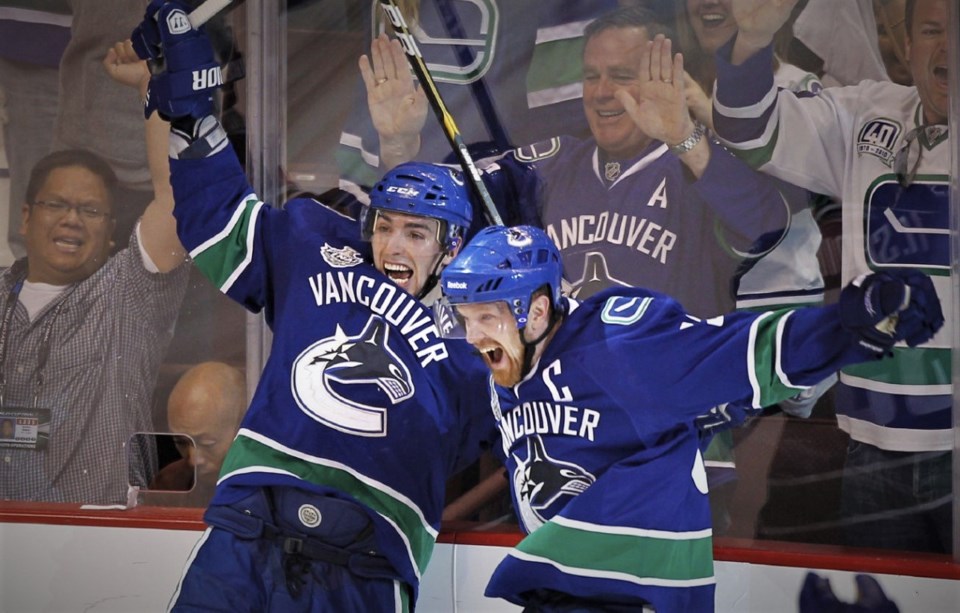Alex Burrows is back in Vancouver for the first time since he was traded to the Ottawa Senators. Elsewhere in the NHL, another Alex scored back-to-back hat tricks in the first two games of the season for the first time in 100 years. Ovechkin’s historic hat tricks and Burrows coming back to town brings to mind his own back-to-back hat tricks.
It came in 2010, in the middle of Henrik Sedin’s Art Ross season. On the tail end of the Canucks’ longest point-streak of the season, Burrows lit up the Columbus Blue Jackets and Phoenix Coyotes for six goals. The unlikely feat was just part of an incredibly unlikely career.
The six goals in two games were part of a 12-game point streak for Burrows that saw him score 13 goals and 19 points. By the end of the season he had a career-high 35 goals to lead the Canucks in goalscoring. To get from where he started — undrafted and playing in the ECHL — to leading one of the best teams in the NHL in goalscoring is an unparalleled hockey journey.
That’s one of the big reasons why Burrows became a fan favourite in Vancouver. It wasn’t just his penchant for getting under the skin of his opponents, his scrappy two-way game, or scoring clutch goals, though those certainly helped. It was how Canucks fans saw him come from nothing.
Plenty of current NHL players spent a bit of time in the ECHL, but it’s usually a very short visit. It becomes clear very quickly which players are too good for the ECHL and belong in a higher league. If you look at a list of notable ECHL alumni, other than goaltenders, most played just part of one season in the ECHL, sometimes even just a few games.
Burrows played two full seasons in the ECHL, split between the Greenville Grrrowl, Baton Rouge Kingfish, and Columbia Inferno. Players that spend two full seasons in the ECHL are incredibly unlikely to make the NHL, let alone ever play on a top line.
In retrospect, the biggest moment of his entire hockey career may have been the ECHL contract he signed with the Inferno. The Inferno were the ECHL affiliate of the Manitoba Moose and Vancouver Canucks and Burrows ended up on a line with the Canucks’ 9th-round draft pick from 2000, Tim Smith.
Burrows helped Smith to the ECHL scoring title and grabbed the attention of Moose general manager Craig Heisinger, signing an AHL contract with the Moose. Two seasons later, he was in the Canucks’ lineup.
That was the pattern for Burrows: constant improvement. In his first season in the QMJHL, he had 30 points in 63 games. In his second season, he more than doubled his points with 70 in 64 games. He had 32 points in 64 games in his first season in the ECHL. He more than doubled his point to 73 in 64 games in his second ECHL season.
It was the same in the AHL: 26 points in 72 games in his first season, then 30 points in 33 games in his second season, more than doubling his points-per-game. How could the Canucks resist calling him up to the NHL? And once he was there, he refused to leave.
While Burrows found success alongside Ryan Kesler, he was at his best when with the Sedins. That shouldn’t come as a surprise — a lot of players were at their best with the Sedins — but he also brought out the best in them. There’s a reason why the Sedins won back-to-back scoring titles with Burrows on their wing: his game perfectly complemented theirs.
It was a style of game honed in another unlikely place: ball hockey. Burrows is a legendary ball hockey player, a member of both the Canadian and International Ball Hockey Halls of Fame, and he looks like a ball hockey player on the ice. His choppy skating style frequently looks like he’s running instead of skating, but it effectively got him where he wanted to go in a hurry. Once there, the stick battles that are a hallmark of ball hockey helped him win puck battles along the boards, freeing the puck up for the Sedins.
In front of the net, he was in constant motion, spinning off checks and battling for position, an approach to being a net front presence more familiar to ball hockey than ice hockey. Then, when the puck came to his stick, he released it with a snap, the exact type of quick finish needed when the Sedins find you open in front of the net.
Even after he proved what a great fit he was with the Sedins, it seemed like he constantly had to prove himself again, with other players brought in as a “perfect fit.” But no one quite managed to match what Burrows brought to their line. Perhaps Jannik Hansen, another unlikely success story, came closest.
Without Burrows, Canucks history could have been significantly different. Just look at his short-handed goal against the Carolina Hurricanes in 2009: the Canucks were mired in an eight-game losing streak and had won just three of their last 16 games. After going up 2-0 in the first period, they let the lead slip away and were tied 3-3 late in the first. Fans feared a repeat of several other nights in that streak: a loss in overtime or the shootout to continue the slump.
Instead, Kesler and Burrows combined for an iconic goal, featuring one of the earliest appearances of Blue Steel, his go-to breakaway move.
Or imagine if Burrows had never slayed the dragon and the Canucks lost to the Chicago Blackhawks in 2011 for the third straight year.
So, when Burrows takes the Rogers Arena ice Tuesday night for the first time in a Senators sweater, he deserves a long and loud ovation.



